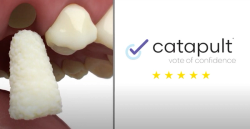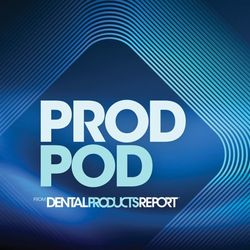- About Us
- Advertise
- Editorial
- Contact Us
- Terms and Conditions
- Privacy Policy
- Do Not Sell My Personal Information
© 2025 MJH Life Sciences™ and Dental Products Report. All rights reserved.
Step-by-Step: How to use GC Initial for even complicated cases [VIDEO]
The most challenging question ceramists face today is which material, what ingot, or what layering porcelain is best for specific patients with unique expectations and prescriptions.
The most challenging question ceramists face today is which material, what ingot, or what layering porcelain is best for specific patients with unique expectations and prescriptions.
They must consider how the color of the preparation will influence the final shade on the veneer, or how the crown will hold up to the forces that destroyed the dentition.
These questions and many more are part of the impossible equation of selecting a restorative material. Have you made your decision? Was it based on the call from that doctor who said “my patient was so happy she couldn’t stop crying, it’s one of the most beautiful cases I’ve ever delivered” or does the discussion revolve around the “it’s perfect except that black prep in the middle.”
To make the decision even more challenging, all the products we use can produce beautiful results, and they all have countless studies proving their durability and superiority. So what do we do? With the available technology I honestly think you cannot make a bad decision, but I strongly believe you can increase your odds and decrease your stress by choosing a system with strengths that are aligned with the product you’re trying to produce.
I need the flexibility and consistency to cross all platforms. I need a powder that has enough power and richness to block the darkest prep yet delicate enough to create the depth and vitality that today’s patient demands. GC America’s porcelain, GC Initial™ gives me that.
A VIDEO OF THE STEP-BY-STEP TECHNIQUE:
Case presentation
A 55-year-old male patient has the desire to enhance his smile’s appearance with in-office whitening. He wanted a more youthful smile, as he was about to embark on a new employment venture. After the whitening consult, a comprehensive records examination-including a TMJ/occlusal evaluation, restorative charting, full periodontal probing and oral cancer screening-was performed. The patient had old crowns, bonding and broken fillings with decay present, so the dentist developed a restorative component to the patient’s treatment plan to fully realize the desired result.
Initial treatment
The patient’s discolored dentition made him a good candidate for whitening. His dental assistant decided on an in-office whitening procedure (Ultradent Opalescence® Boost 40%) in combination with a nightguard vital bleaching procedure (Ultradent Opalescence®) that consists of viscous 10% carbamide peroxide material in a syringe delivery system.
Follow-up and treatment planning
During the follow-up visit, the patient was highly satisfied with the whitening results, but agreed restorative procedures were necessary to accomplish his esthetic goals. Diagnostic models were taken and mounted with the Slidematic facebow (Whipmix Corp.) in centric relation on a Denar® combination articulator (Whip Mix Corp.). The esthetic goals were waxed into position by the laboratory ceramist (Walt Richardson of Bayview Dental Laboratory). This model was used to fabricate provisional matrices.
Treatment plan
Discussion led to agreement on a treatment plan consisting of restoring tooth Nos. 4-12 using GC Initial Porcelain. The patient did not want any tissue adjustments. The goal was to add 1.25 mm vertical length, while positioning the restorations slightly more lingually to allow for a more harmonious lip closure path.
Provisional restorations
Tooth Nos. 4-12 were prepared for GC Initial Porcelain bonded restorations. The dentition was equilibrated to centric relation. After final impressions and jaw relation records, the teeth were provisionally restored with Structure 3 Provisional Material (VOCO America) and cemented with GC Fuji Temp LT (GC America). The restorations were then systematically contoured to provide all the requirements of stable occlusion and to satisfy the patient’s esthetic needs.
The patient was seen for a 48-hour follow-up appointment to evaluate esthetics and envelope of function. When all parameters were met to satisfy doctor and patient, an impression was made of the provisional restorations, digital photographs were taken of the patient’s face, and a bite record was made to aid in the cross mounting with the die model in the laboratory. The photographs, impression and bite record served as blueprints, communicating to the laboratory what the final restorations should look like.
Laboratory fabrication
The dentist wanted to use a universal all-ceramic system containing zirconia for this case. He and Matt Shafer, CDT, decided on Initial Porcelain because of its high strength, incredible esthetic properties and easy processing. The following are the steps to fabricate the restorations:
01 Using the impressions of the patient’s teeth before the provisional restorations were placed and a provisional model, zirconia copings for the restorations were designed and milled.
02 A porcelain layering technique was used to create an optimal esthetic appearance with a process that is easily learned, efficient, cost-effective and not technique-sensitive.
03 GC Initial™ Lustre Paste was applied to the restorations before beginning the build-up to shade the copings. A combination of Opacious Dentin Modifier, Inside and Fluorescent Dentin powders were applied to establish proper color saturation and reflective zones.
04 Standard dentin mixes and a proper lingual/incisal edge matrix were used to layer functional lingual contours. With the working side established, we could focus all our attention on a true-to-nature build-up process.
05 The incisal was contoured with enamel or transparent mixtures, and by means of a “cut-back” technique, the area was reduced to internal dentin levels. The reduced area was reconstructed with reflective dentins and transparent enamels in the desired anatomic structure. This was a very important point for color synchronization. One does not wish to wash out, or allow excessive show-through of the internal structures of the crowns. The final contouring was built from a mixture of Enamel Opalescence (EOP) standard Enamel (E) and CL-F.
06 The restorations were checked on trimmed and untrimmed models to ensure proper proximal contacts, margin accuracy, function and occlusion. The final GC Initial restorations were sent to the dentist for placement.
Delivery appointment
07 The final restorations were evaluated and inspected for marginal fit on the master dies. The patient was anesthetized, and the provisionals were carefully cut away in sections so the underlying tooth structure would not be damaged. The exposed preparations were cleaned with chlorhexadine scrub (Consepsis, Ultradent), and each individual restoration was tried in with water to check the marginal fit, occlusion, esthetics, and final color. The patient approved delivery of the restorations.
08 After patient approval, the restorations were rinsed and dried, etched with 37 percent phosphoric acid, and silanated with Ultradent’s Porcelain Etch and Silane.
09 The definitive restorations were bonded into place using GC FujiCEM™ 2 Automix (GC America) glass-ionomer luting cement dispensed directly into the restorations with its syringe delivery system. Excess cement was removed from interproximal areas by careful flossing. Final cement cleanup and occlusal adjustments under water were completed. When viewing the finished restoration, the optimum incisal placement was noted from a vertical and horizontal perspective, and precise placement toward the inner vermillion border of the lip established the desired lip closure.
Closing thought
This patient presented with a discolored, aged smile and wanted to look more youthful for his new employment venture. Through careful treatment planning, excellent hygienist work, outstanding laboratory communication, and talented restorative dentistry, the entire dental team helped him achieve his esthetic goal. As demonstrated by this case, it is imperative to have appropriate and predictable restorative materials like GC Initial Porcelain for esthetic dental treatments, as well as a talented, well-communicating restorative team to perform them.



